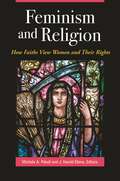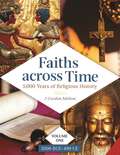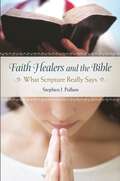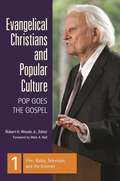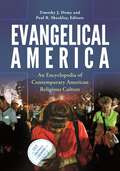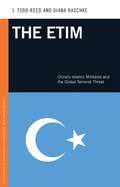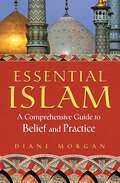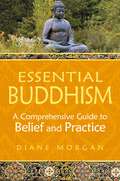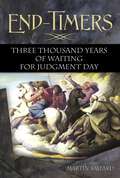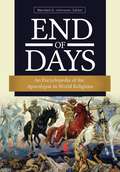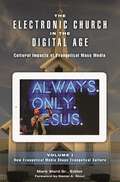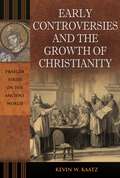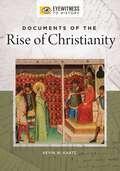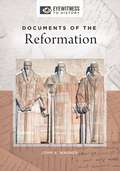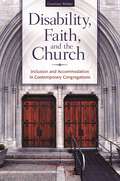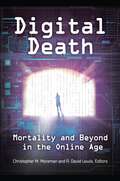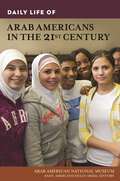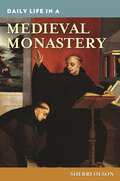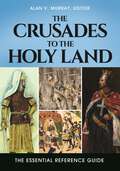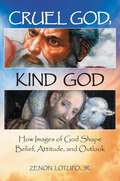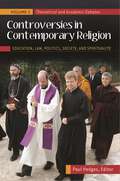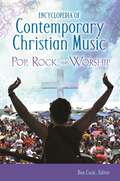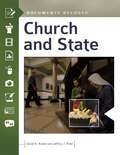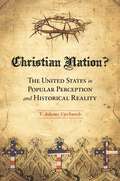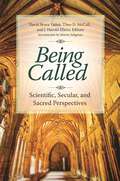- Table View
- List View
Feminism and Religion: How Faiths View Women and Their Rights (Women's Psychology)
by Michele A. Paludi and J. Harold Ellens, EditorsRenowned subject experts Michele A. Paludi and J. Harold Ellens lead readers through a detailed exploration of the feminist methods, issues, and theoretical frameworks that have made women central, not marginal, to religions around the world.At a conference in 2013, Gloria Steinem noted that religion is the "biggest problem" facing feminism today. In this insightful volume, a team of researchers, psychologists, and religious leaders led by editors Michele A. Paludi and J. Harold Ellens supply their expertise and informed opinions to examine the problems, spur understanding, and pose solutions to the conflicts between religion and women's rights, thereby advocating a global interest in justice and love for women. Examples of subjects addressed include the pro-life/pro-choice debate, feminism in new age thought, and the complex intersections of religion and feminism combined with gender, race, and ethnicity.The contributed work in this unique single-volume book enables a better understanding of how various religions view women—both traditionally and in the modern context—and how feminist thinking has changed the roles of women in some world religions. Readers will come away with clear ideas about how religious cultures can honor feminist values, such as family-friendly workplace policies, reproductive justice, and pay equity, and will be prepared to engage in conversation and constructive debate regarding how faith and feminism are interrelated today.
Faiths across Time [4 volumes]: 5,000 Years of Religious History [4 volumes]
by J. Gordon MeltonThis monumental, four-volume reference overviews significant events and developments in religious history over the course of more than five millennia.Written for high school students, undergraduates, and general readers interested in the history of world religions, this massive reference chronicles developments in religious history from 3500 BCE through the 21st century. The set comprises four volumes, treating the ancient world from 3500 BCE through 499 CE, 500 through 1399, 1400 through 1849, and 1850 through 2009. Each volume includes hundreds of brief entries, arranged chronologically and then further organized by region and religion. The entries provide fundamental information on topics ranging from the neolithic Ggantija temples near Malta through the election of Mary Douglas Glasspool as bishop of the Episcopal Diocese of Los Angeles in 2009. Global in scope and encyclopedic in breadth, this chronology of world religions is an essential purchase for all libraries concerned with the development of human civilization.
Faith Healers and the Bible: What Scripture Really Says
by Stephen J. PullumAn insightful read for anyone who is interested in religion, this book offers fresh, biblical insight into the preaching of faith healing from a Christian perspective.Faith healing has been a popular religious phenomenon in this country for well over a hundred years, gaining thousands of followers and raking in millions of dollars annually. What faith healers teach, however, often goes unchallenged. Faith Healers and the Bible: What Scripture Really Says offers an informed critique of many of the themes found in faith healers' preaching that documents that much of what they teach is not biblically based—contrary to what they would like their listeners to believe.Drawing on a lifetime of study and nearly two decades of teaching a university course titled "The Rhetoric of Faith Healing," Stephen J. Pullum, PhD, provides scriptural insight into the false claims frequently found in the preaching of healing revivalists. After an introductory chapter that explains why faith healers have been so persuasive, the author addresses a breadth of topics, including the miraculous, the providential, demon possession, the call of God, the indwelling of the Holy Spirit, and the health and wealth gospel. Meeting faith healers on their own turf—the Bible—Pullum clearly demonstrates that much of what faith healers preach cannot be scripturally supported.
Evangelical Christians and Popular Culture [3 volumes]: Pop Goes the Gospel [3 volumes]
by Robert H. WoodsThis three-volume collection demonstrates the depth and breadth of evangelical Christians' consumption, critique, and creation of popular culture, and how evangelical Christians are both influenced by—and influence—mainstream popular culture, covering comic books to movies to social media.Evangelical Christians and Popular Culture: Pop Goes the Gospel addresses the full spectrum of evangelical media and popular culture offerings, even delving into lesser-known forms of evangelical popular culture such as comic books, video games, and theme parks. The chapters in this 3-volume work are written by over 50 authors who specialize in fields as diverse as history, theology, music, psychology, journalism, film and television studies, advertising, and public relations. Volume 1 examines film, radio and television, and the Internet; Volume 2 covers literature, music, popular art, and merchandise; and Volume 3 discusses public figures, popular press, places, and events.The work is intended for a scholarly audience but presents material in a student-friendly, accessible manner. Evangelical insiders will receive a fresh look at the wide variety of evangelical popular culture offerings, many of which will be unknown, while non-evangelical readers will benefit from a comprehensive introduction to the subject matter.
Evangelical America: An Encyclopedia of Contemporary American Religious Culture
by Timothy J. Demy and Paul R. Shockley, EditorsAn essential new reference work for students and general readers interested in the history, dynamics, and influence of evangelicalism in recent American history, politics, and culture.What makes evangelical or "born-again" Christians different from those who identify themselves more simply as "Christian"? What percentage of Americans believe in the Rapture? How are evangelicalism and Baptism similar? What is the influence of evangelical religions on U.S. politics? Readers of Evangelical America: An Encyclopedia of Contemporary American Religious Culture will learn the answers to these questions and many more through this single-volume work's coverage of the many dimensions of and diversity within evangelicalism and through its documentation of the specific contributions evangelicals have made in American society and culture. It also illustrates the Evangelical movement's influence internationally in key issues such as human rights, environmentalism, and gender and sexuality.
The ETIM: China's Islamic Militants and the Global Terrorist Threat (PSI Guides to Terrorists, Insurgents, and Armed Groups)
by J. Todd Reed Diana RaschkeThis comprehensive account examines the East Turkistan Islamic Movement (ETIM)—the most significant Muslim militant group in China—including its origins, objectives, ideology, leadership, and tactics.To effectively engage China on counterterrorism issues, we must understand the capabilities and intentions of the East Turkistan Islamic Movement (ETIM), the most significant Muslim militant group in China. The ETIM: China's Islamic Militants and the Global Terrorist Threat is the first book to focus specifically on the ETIM, a terrorist group that demands an independent Muslim state for the Uyghur ethnic minority in northwest China. This fascinating study offers a comprehensive account of the group's origins, objectives, ideology, leadership, and tactics. It details the historical and contemporary contexts of the Uyghur separatist movement, the ETIM's alleged ties to international terrorist networks, and the Chinese government's interest in promoting the ETIM as a significant international problem. In addition, the book addresses conflicting claims about the membership and viability of the organization, noting where the Chinese government has apparently manipulated information about the ETIM to suit its own goals. A final chapter explores how various countries define ETIM activities and what that means for relations with China.
Essential Islam: A Comprehensive Guide to Belief and Practice (Non-ser.)
by Diane MorganAn introductory guide to the important elements of the world's largest religion, including the Quran, the Pillars of Faith, and the life of Muhammad, as well as Islamic history, customs and rituals, and contributions to world culture.Essential Islam: A Comprehensive Guide to Belief and Practice is the ideal beginner's resource on the core elements of a faith that, like Christianity and Judaism, offers a guide to holy living and a path to salvation—one that like other world faiths has inspired peace and war, tolerance and brutality, enlightenment and abysmal ignorance.Essential Islam offers an insightful, objective look at Islam from its inception to the present day, including a discussion of Islamic beliefs about God, history, warfare, marriage, the afterlife, and the relationship between Islam and other faiths. It is a rich source for dispelling misconceptions—for example, only 10 percent of Muslims are Arabic, and only a quarter of those reside in the Middle East—and for understanding tensions between groups within and outside Islam. More importantly, it gives readers a portrait of Islam not as a religion of extremists, but as a dynamic living faith practiced by people of all kinds in virtually every corner of the world.
Essential Buddhism: A Comprehensive Guide to Belief and Practice
by Diane MorganAn engaging, clear-sighted book that covers all aspects of this rich, peaceful, and insightful tradition.Author Diane Morgan brings her compelling writing style and deep understanding to Essential Buddhism: A Comprehensive Guide to Belief and Practice. This lively book presents a clear, thorough, and objective introduction to the many facets of Buddhist philosophy and faith, including basic beliefs, major texts, practices, and important figures of each branch of the tradition. The book devotes an entire chapter of the remarkable life of the Buddha, from his amazing conception to his future appearance. It discusses the sophisticated way in which Buddhism intertwines its complex metaphysics and practical ethics through the Four Noble Truths, the Eightfold Noble Path, and the doctrine of Dependent Arising, and also devotes detailed attention to such Buddhist basics as the Wheel of Becoming, the mysterious world of Tantra, and the riddles of Zen. Complete with stories, koans, and biography, the book will help readers see how each tradition developed within the larger context of the faith, even as they explore Buddhism's remarkable facility for liberating the mind.
End-Timers: Three Thousand Years of Waiting for Judgment Day
by Martin BallardThis fascinating history surveys apocalyptic religion through time, setting it within a political and social context.End-Timers: Three Thousand Years of Waiting for Judgment Day examines the high and low points of millennial expectation across the centuries. It shows how and why such beliefs first developed in antiquity, and it explores how end-timers influenced events as varied as the persecutions of Hellenistic ruler Antiochus Epiphanes and Roman Emperor Nero, the Crusades, the settlement of North America, and the 20th-century debacles at Jonestown and Waco.Suggesting that anyone who wishes to understand the Middle East today needs to penetrate the background of modern fundamentalism within the three Semitic religions, the author illuminates the part played by Christian Zionists in promoting the return of the Jews to the "promised land" and the resulting formation of the state of Israel, as well as subsequent fundamentalist reactions within both Judaism and Islam. He also follows the birth of the "Christian Right" in 19th-century Britain and its development and growing influence in the United States. Finally, the book examines how religious end-timers confront the four horsemen of the 21st-century apocalypse: world population increase, depletion of natural resources, advanced weaponry, and global warming.
End of Days: An Encyclopedia of the Apocalypse in World Religions
by Wendell G. JohnsonCovering religious traditions ranging from Buddhism to Christianity to Zoroastrianism and modern apocalyptic movements such as Arun Shinrikyo and the Branch Davidians, this book addresses prophesied end of days from a breadth of perspectives and includes material on often-neglected themes and genres.End of Days: An Encyclopedia of the Apocalypse in World Religions describes apocalyptic writings in the world's major religious traditions, including Judaism, Christianity, Islam, Hinduism, and Buddhism. The cross-referenced entries address ancient traditions—Zoroastrianism, as one example—as well as modern apocalyptic movements, such as Arun Shinrikyo, the Branch Davidians, and the Order of the Solar Temple.This book's broad scope offers coverage of overlooked traditions, such as Mayan Apocalyptic, Norse Apocalyptic, Native American eschatological literatures, and the Tibetan Book of the Dead. Readers seeking detailed information on the eschatological and apocalyptic movements and proponents of End Times can reference entries about individuals such as Harold Camping, Jerry Falwell, David Koresh of the Brand Davidians, and James Jones and the People's Temple. This single-volume encyclopedia also contains numerous historical entries on subjects such as the Great Disappointment, the Great Awakening periods of religious revival, Joachim of Flora, the Maccabean Revolt, and the Plymouth Brethren. The influence of apocalyptic ideas far outside the realm of religion itself is documented through entries on film, including well-known modern movies such as The Hunger Games and Apocalypse Now, literature by writers such as Dante, and works of fine art like Wagner's Götterdämmerung. The inclusion of entries related to literature, film, and other art forms further attests to the wide-ranging social influence of belief in the end of days.
The Electronic Church in the Digital Age [2 volumes]: Cultural Impacts of Evangelical Mass Media [2 volumes]
by Mark WardThis two-volume set investigates the evangelical presence in America as experienced through digital media, examining current evangelical ideologies regarding education, politics, family, and government.Evangelical broadcasting has greatly expanded its footprint in the digital age. This informative text acquaints readers with how the electronic church of today spreads its message through Internet podcasts, social networking, religious radio programs, and televised sermons; how mass media forms the institution's modern identity; and what the future of the industry holds as mobile church apps, Christian-based video games, and online worship become the norm.The work—split into two volumes—reveals the ways that the Christian broadcast community affects evangelical traditions and influences American society in general. Volume 1 explores how electronic media shapes today's Christian subculture, while the second volume describes how the electronic church impacts the wider American culture, analyzing what key figures in evangelical mass media are saying about today's religious, political, economic, and social issues. The set concludes by addressing criticism about religious media and the prospects of American public discourse to accomodate both secular and religious voices.
Early Controversies and the Growth of Christianity (Praeger Series on the Ancient World)
by Kevin W. KaatzThis revealing history examines the controversies, maneuvering, and political wrangling that occupied the Christian Church for the first four centuries of its existence.Drawing from primary texts, Early Controversies and the Growth of Christianity reveals how the religion was formed through a series of conflicts that occurred primarily between Christian groups. Presenting a close examination of the first four centuries of Christian history through the lens of the controversies that animated, disturbed, and finally formed the Church, the book will enable readers to become familiar with the lives and writings of the early Christians and to better understand the fascinating history of early Christianity.The book focuses on several major early controversies. These include controversies surrounding the apostle Paul; controversies concerning the apostolic fathers, especially the idea of a pope and the role of the bishop/priest; Marcion and his influence; Manichaeism and Gnosticism; persecution and the Dontatists; Arianism; the rise of the bishop in the late 4th century; and power struggles between church and state. Each chapter focuses on the primary texts and key players in the battle over what would finally become orthodox Christianity, demystifying many poorly understood events that ultimately helped define today's Church.
Documents of the Rise of Christianity: History, Documents, And Key Questions (Eyewitness to History)
by Kevin W. KaatzAn introduction to the history of early Christianity, this reference provides roughly 60 primary source documents from the first five centuries of the Christian Era, each accompanied by explanatory material.Christianity has been one of the most powerful influences on world history, and for this reason the world of the early Christians figures prominently in film, fiction, and popular culture. The first centuries of Christianity provided the foundation for the faith institutions of today; this book examines the history of early Christianity through its use of primary texts written by early Christians. In doing so, it helps readers to understand that multiple sects of Christianity competed for dominance, and it sheds light on the struggles of early Christians that their differences entailed.The book covers the first five centuries of the Christian Era, with sections devoted to each century. Some 60 primary source documents appear within those sections, and each is accompanied by background information. This chronological arrangement helps readers to understand how Christianity evolved over time, and it provides insights into the theological debates and persecutions that marked the lives of early Christians and characterized the early Church.
Documents of the Reformation (Eyewitness to History)
by John A. WagnerAn engaging and accurate introduction to the Protestant Reformation, told in the words of those who led it, opposed it, and lived it.The Protestant Reformation was a pivotal event in world history and religion. Documents of the Reformation collects more than 60 primary documents that shed light on the personalities, issues, ideas, and events of the 16th-century upheaval and will help readers to understand how and why the Protestant Reformation began and transpired as it did. The book is divided into 12 sections on topics such as indulgences, persecution, and women in the Reformation, each of which offers five document selections. Detailed introductions preceding the documents put them into historical context and explain why they are important, while a general introduction and chronology help readers to understand the Reformation in broad terms and to see causal connections. Bibliographies of current print and digital resources attend each document, and a general bibliography lists seminal works on the Reformation.
Disability, Faith, and the Church: Inclusion and Accommodation in Contemporary Congregations
by Courtney Wilder Ph.D.Including both theoretical discussions and practical information for congregational use or pastoral use, this rich, accessible book explores biblical text, historical and theological issues of disability, and examples of successful ministry by people with disabilities.Disability, Faith, and the Church: Inclusion and Accommodation in Contemporary Congregations draws from a range of Christian theologians, denominational statements, writings of people with disabilities, and experiences of successful ministries for people with disabilities to answer the deep need of many Christian communities: to live out their calling by welcoming all people. By focusing on 20th- and 21st-century thinkers and political and religious practices, the book outlines best practices for congregations and supplies practical information that readers can apply in classroom or church settings.The author draws on thinkers from a variety of Christian traditions—including Roman Catholicism, Episcopalianism, Lutheranism, and the Reform traditions—to provide a theologically robust discussion that remains accessible to churchgoers without formal theological training. Emphasis is placed on connecting formal theological reflection and the experiences of ordinary people with disabilities to existing congregational practices and denominational statements, thereby enabling readers to decide on the best ways to successfully include people with disabilities into their communities within the rich and diverse Christian theological tradition.
Digital Death: Mortality and Beyond in the Online Age
by Christopher M. Moreman A. David LewisThis fascinating work explores the meaning of death in the digital age, showing readers the new ways digital technology allows humans to approach, prepare for, and handle their ultimate destiny.With DeadSocial™ one can create messages to be published to social networks after death. Facebook's "If I Die" enables users to create a video or text message for posthumous publication. Twitter _LIVESON accounts will keep tweeting even after the user is gone. There is no doubt that the digital age has radically changed options related to death, dying, grieving, and remembering, allowing people to say goodbye in their own time and their own unique way. Drawing from a range of academic perspectives, this book is the only serious study to focus on the ways in which death, dying, and memorialization appear in and are influenced by digital technology. The work investigates phenomena, devices, and audiences as they affect mortality, remembrances, grieving, posthumous existence, and afterlife experience. It examines the markets to which the providers of such services are responding, and it analyzes the degree to which digital media is changing views and expectations related to death. Ultimately, the contributors seek to answer an even more important question: how digital existences affect both real-world perceptions of life's end and the way in which lives are actually lived.
Daily Life of Arab Americans in the 21st Century (The Greenwood Press Daily Life Through History Series)
by Anan Ameri Holly AridaThis much-needed study documents positive Arab-American contributions to American life and culture, especially in the last decade, debunking myths and common negative perceptions that were exacerbated by the 9/11 attacks and the War on Terror.The term "Arab American" is often used to describe a broad range of people who are ethnically diverse and come from many countries, including Lebanon, Syria, Palestine, Jordan, Iraq, Saudi Arabia, Yemen, Oman, United Arab Emirates, Qatar, Bahrain, and Kuwait. Some Arab Americans have been in the United States since the 1880s. The terrorist attacks of September 11, 2001 did serve to highlight the necessity for Americans to better understand the discrete nations and ethnicities of the Middle East.This title documents the key aspects of contemporary Arab American life, including their many contributions to American society. It begins with an overview of the immigrant experience, but focuses primarily on the past decade, examining the political, family, religious, educational, professional, public, and artistic aspects of the Arab American experience. Readers will understand how this unique experience is impacted by political events both here in America and in the Arab world.
Daily Life in a Medieval Monastery (The Greenwood Press Daily Life Through History Series)
by Sherri OlsonA study of life inside medieval monasteries that explores monastic spirituality, daily routines, contact with the outside world, and the historical impact of these foundational institutions on the Western world.How did the Western monastic tradition begin? What was monastic life typically like for a monk or nun? How was the institution of the monastery formative to Western culture from antiquity through the Middle Ages? This book covers the entire span of monastic history in the late-ancient and medieval periods and provides an in-depth look at several monasteries across Europe. Each chapter introduces the reader to the surviving evidence for the houses studied, such as its monastic rules, plans, records of visitation, chronicles, and biographical accounts; and aims to give an "insider" view—not only of monks' and nuns' daily activities, but what these dedicated individuals' values, ambitions, and aspirations might have been.
The Crusades to the Holy Land: The Essential Reference Guide
by Alan V. Murray, EditorBased on the latest scholarship by experts in the field, this work provides an accessible guide to the Crusades fought for the liberation and defense of the Holy Land—one of the most enduring and consequential conflicts of the medieval world.The Crusades to the Holy Land were one of the most important religious and social movements to emerge over the course of the Middle Ages. The warfare of the Crusades affected nearly all of Western Europe and involved members of social groups from kings and knights down to serfs and paupers. The memory of this epic long-ago conflict affects relations between the Western and Islamic worlds in the present day. The Crusades to the Holy Land: The Essential Reference Guide provides almost 90 A–Z entries that detail the history of the Crusades launched from Western Europe for the liberation or defense of the Holy Land, covering the inception of the movement by Pope Urban II in 1095 up to the early 14th century. This concise single-volume work provides accessible articles and perspective essays on the main Crusade expeditions as well as the important crusaders, countries, places, and institutions involved. Each entry is accompanied by references for further reading. Readers will follow the career of Saladin from humble beginnings to becoming ruler of Syria and Egypt and reconquering almost all of the Holy Land from its Christian rulers; learn about the main sites and characteristics of the castles that were crucial to the Christian domination of the Holy Land; and understand the key aspects of crusading, from motivation and recruitment to practicalities of finance and transport. The reference guide also includes survey articles that provide readers with an overview of the original source materials written in Latin, Arabic, Greek, Hebrew, Armenian, and Syriac.
Cruel God, Kind God: How Images of God Shape Belief, Attitude, and Outlook (Psychology, Religion, and Spirituality)
by Zenon Lotufo Jr.This enlightening analysis of the image of a cruel God sustained by conservative Christianity reveals how this image formed, the psychological effects of this concept, and the ways in which it has guided religious individuals—in both positive and negative ways.This book is born, in large measure, as a result of a writing by contemporary theologian J. Harold Ellens. In his essay "Religious Metaphors Can Kill" from Praeger's The Destructive Power of Religion, Ellens espouses that theological doctrines are rooted in a model of God that determines all the aspects of those doctrines, and strongly influences the cultures into which it is inserted. Conservative Christianity in the Western world, says Ellens, has at its center the image of a cruel and wrathful God. The juridical atonement theory of Anselm is a result of such an image of God, and has an important role in justifying the resort to violence in human interaction.Starting from these considerations, Cruel God, Kind God: How Images of God Shape Belief, Attitude, and Outlook analyzes three general topics: how two very different kinds of Christianities have emerged from these disparate images of God; how the doctrines of "original sin," "the plan of salvation," and "penal substitution" can be explained by psychological factors, as can the wide dissemination and acceptance of these doctrines; and how the image of a cruel God affects mental health, atrophies personality, and produces guilt and shame.
Controversies in Contemporary Religion [3 volumes]: Education, Law, Politics, Society, and Spirituality [3 volumes]
by Paul HedgesReligious or spiritual beliefs underpin many controversies and conflicts in the contemporary world. Written by a range of scholarly contributors, this three-volume set provides contextual background information and detailed explanations of religious controversies across the globe.Controversies in Contemporary Religion: Education, Law, Politics, Society, and Spirituality is a three-volume set that addresses a wide variety of current religious issues, analyzing religion's role in the rise of fundamentalism, censorship, human rights, environmentalism and sustainability, sexuality, bioethics, and other questions of widespread interest. Providing in-depth context and analysis far beyond what's available in the news or online, this work will enable readers to understand the nature of and reasons for controversies in current headlines. The first volume covers theoretical and academic debates, the second looks at debates in the public square and ethical issues, while the third examines specific issues and case studies.These volumes bring detailed and careful debate of a range of controversies together in one place, including topics not often covered—for example, how religions promote or hinder social cohesion and peace, the relationship of religions to human rights, and the intersection of Buddhism and violence. Written by a range of experts that includes both established and emerging scholars, the text explains key debates in ways that are accessible and easy to understand for lay readers as well as undergraduate students researching particular issues or global religious trends.
Encyclopedia of Contemporary Christian Music: Pop, Rock, and Worship
by Don CusicThe first comprehensive overview of contemporary inspirational music, covering its historical roots and dramatic growth into one of America's most vital music genres.The Encyclopedia of Contemporary Christian Music: Pop, Rock, and Worship is the first comprehensive reference work on a form of American music that is far more popular than nonfans may realize. It fills a major gap in the literature on American music and Christian culture, looking at this increasingly popular genre in the context of the overall history of religious music in the United States. With over 200 entries, The Encyclopedia of Contemporary Christian Music covers important performers and industry figures, songs and albums, concerts and festivals, the rise of Christian radio and television, and other issues related to the growth of inspirational music. Scholars and fans alike will find a wealth of revealing information and insightful coverage illustrating the influence of gospel on modern American music with musicians such as Elvis, Sam Cooke, Johnny Cash, Bob Dylan, and U2.The work also examines the use of fundamental rock, pop, and rap music templates in the service of songs of faith.
Church and State: Documents Decoded (Documents Decoded)
by David K. Ryden Jeffrey J. PoletThis thoroughly annotated document collection gives students and researchers an authoritative source for understanding the evolving political and legal relationship between church and state from colonial times to the present day.The First Amendment to the Constitution of the United States declares that "Congress shall make no law respecting an establishment of religion, or prohibiting the free exercise thereof." The Establishment Clause, meanwhile, declares a position of neutrality not only between differing religions, but between religious and nonreligious beliefs. The terms of the Free Exercise Clause, however, provide special protections to religious belief and practice. Thus the provisions of the two clauses can clash. In fact, differing political and legal interpretations of these clauses have resulted in some of the most hard-fought and contentious philosophical battles in American history.This book provides readers with convenient access to pertinent documents and court cases that enables a deeper understanding of the past and current balance between church and state and its political implications in the 21st century. The expert commentary that accompanies these key documents serves to elucidate how interpretation of the U.S. Constitution affects issues such as whether public funds or other public support should go to religious-based schools or hospitals; how to safeguard individuals' rights to religious expression while also considering how individuals should not be forced to participate in mandatory religious expressions in public institutions; and how the language regarding "separation of church and state" came about, when this phrase does not appear anywhere in the Constitution.
Christian Nation?: The United States in Popular Perception and Historical Reality
by T. Adams UpchurchThis fascinating study examines America's complex and confusing history of arguing with itself over religion and secularism, God and politics, church and state.Hundreds of books are devoted to the ever-timely subject of the separation of church and state in America, but none does exactly what Christian Nation?: The United States in Popular Perception and Historical Reality does. Unlike other studies, this intriguing examination asks the right questions, defines the terms of the debate, explores the widely diverging points of view with equal respect for all sides, and provides insightful commentary and factual conclusions that cut through the clutter.The book begins with several questions: Is the United States a "Christian Nation?" Has it ever been? Was it ever meant to be? What did the Founding Fathers say? How has this issue been interpreted by various individuals and factions over the centuries? The author then surveys the vast literature on this topic, including the U.S. Constitution and Declaration of Independence and the competing and/or complimentary views of various Founding Fathers to arrive at the answers—and, at long last, the truth.
Being Called: Scientific, Secular, and Sacred Perspectives (Psychology, Religion, and Spirituality)
by Martin SeligmanThis unique book is an essential resource for interdisciplinary research and scholarship on the phenomenon of feeling called to a life path or vocation at the interface of science and religion.According to Gallup polls, more than 40 percent of Americans report having had a profound religious experience or awakening that changed the direction of their life. What are the potential mental, spiritual, and even physical benefits of following the calling to take a particular path in life? This standout book addresses the full range of calling experiences, from the "A-ha!" moments of special insight, to pondering what one is meant to do in life, to intense spiritual experiences like Saint Paul on the road to Damascus.Drawing upon the collective knowledge and insight of expert authors from Australia, China, Eastern Europe, Italy, the UK, and the United States, the work provides a comprehensive examination of the topic of callings suitable for collegiate students, professors, and professional scholars interested in topics at the interface of science and religion. It will also benefit general readers seeking the expertise of psychologists, neuroscientists, and theologians from various backgrounds and worldviews who explain why it is important to "do what you were meant to do."
